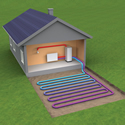Renewable Heat Premium

The government have announced (May 2012) a precursor to the Renewable Heat Incentive for domestic properties, the Phase 2 of the Renewable Heat Premium.
The Renewable Heat Premium is a one-off payment from the government for new installations of heat pumps, solar thermal collectors and Biomass boilers.
The main bullets points of this scheme are:
- Budget is £25m
- Likely subsidy for each technology
- Up to 25,000 installations expected
- Energy efficiency measures important so will be a requirement (probably also for solar thermal)
- Focus is off gas grid (but not exclusively so)
- Monitoring and feedback will be required
- Customer will get RHI tariffs when full scheme introduced in 2013
- Covers all regions of GB
- Not available for new build
The payments are outlined as follows:-
- Air Source Heat Pumps £850
- Ground Source Heat Pumps £1250
- Solar Thermal Collectors £300
- Biomass boiler £950

Available from Dalliam now!
We at Dalliam expect demand to rocket in May 2012 when these payments are officially available.
To manage demand more effectively we have decided to offer these payments to all eligible customers , when the official Renewable Heat Premium scheme is expected to be launched.
To be eligible for the payment customer's properties must have:-
- Cavity wall insulation in walls with cavities.
- At least 270mm of roof insulation where possible.
- A room thermostat and heating time clock. (provided with all Dalliam Heat pump installations)
- Hot water time clock. (provided with all Dalliam Heat pump installations)
- Low energy lighting in suitable light fittings.
- Thermostatic radiator valves in all radiators not in same room as wall thermostat.
- The homeowner must provide feedback as to the performance of the system.
Homeowners using these technologies will also qualify for the renewable heat incentive - quarterly payments for using these low carbon technologies.










